
By Russ Green - Thunder Bay National Marine Sanctuary
On October 7, 2000, the National Oceanic and Atmospheric Administration (NOAA) designated Thunder Bay as the nation’s 13th national marine sanctuary. Thunder Bay National Marine Sanctuary (Thunder Bay NMS) is jointly managed by NOAA and the state of Michigan. The sanctuary’s mission is to preserve nationally significant shipwrecks and regional maritime landscape through resource protection, education, and research. The sanctuary also promotes appreciation and responsible use of Thunder Bay, the Great Lakes, and the oceans.
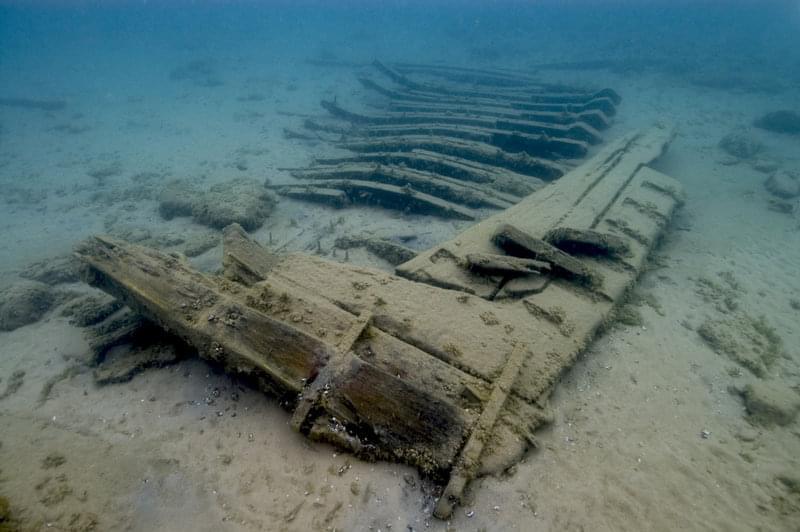
Ships that wreck in shallow water tend to break apart due to the force of wind, waves, and ice. Shallow-water shipwrecks dot the shoreline of Thunder Bay, providing recreational opportunities for snorkeling, diving, and kayaking. Shown here are the remains of the 1840s sidewheel steamer New Orleans, one of the oldest known wrecks in the sanctuary. Image courtesy of Thunder Bay 2010 Expedition, NOAA-OER. Download larger version (jpg, 128 KB).
Located in northwestern Lake Huron, Thunder Bay is adjacent to one of the most treacherous stretches of water within the Great Lakes system. Unpredictable weather, murky fog banks, sudden gales, and rocky shoals earned the area the name “Shipwreck Alley.” Today, the 448-square-mile Thunder Bay National Marine Sanctuary protects one of America’s best-preserved and nationally significant collections of shipwrecks.
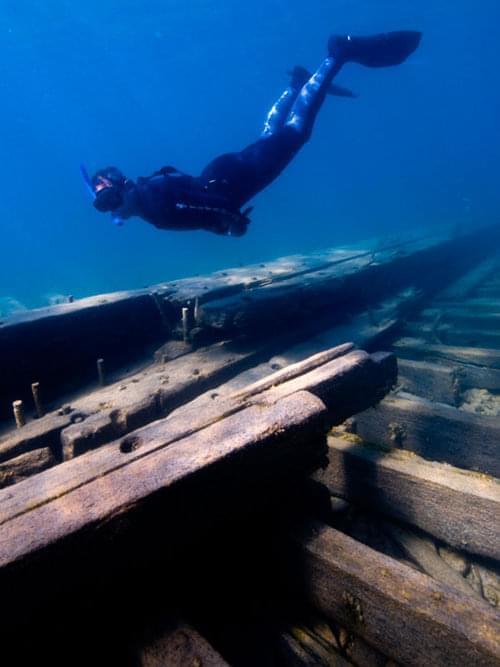
Shallow-water shipwrecks dot the shoreline of Thunder Bay, providing recreational opportunities for snorkeling, diving, and kayaking. Shown here are the remains of both the 1840s sidewheel steamer New Orleans (top photo), one of the oldest known wrecks in the sanctuary, and the schooner American Union. Image courtesy of Thunder Bay 2010 Expedition, NOAA-OER. Download larger version (jpg, 45 KB).
Fire, ice, collisions, and storms have claimed over 200 vessels in and around Thunder Bay. To date, more than 50 shipwrecks have been discovered within the sanctuary, and an additional 30 wrecks have been located outside of the sanctuary boundaries. Although the sheer number of shipwrecks is impressive, it is the range of vessel types located in the sanctuary that makes the collection nationally significant. From an 1844 sidewheel steamer to a modern 500-foot-long German freighter, the shipwrecks of Thunder Bay represent a microcosm of maritime commerce and travel on the Great Lakes.

Protected from the high-energy of a shallow-water environment, deep-water shipwrecks are often very intact. Shipwrecks in this type of environment are true time capsules, providing unique and exciting archeological, historical, and recreational opportunities. The 300-foot-long bulk freighter Norman, which sank in 1895, rests in 64 meters (210 feet) of water just outside the current sanctuary boundaries. The wreck site is among the most exciting dives in the Great Lakes. Image courtesy of Thunder Bay 2010 Expedition, NOAA-OER. Download larger version (jpg, 226 KB).
Northeastern Michigan’s maritime landscape includes the hundreds of shipwrecks located on Lake Huron bottomlands. It also encompasses all of the cultural and natural features related to maritime heritage. Lifesaving stations, lighthouses, historic boats and ships, commercial fishing camps, docks, and working ports are among the more obvious historic and archaeological features. Many features are less visible and some remain unrecognized or unknown.
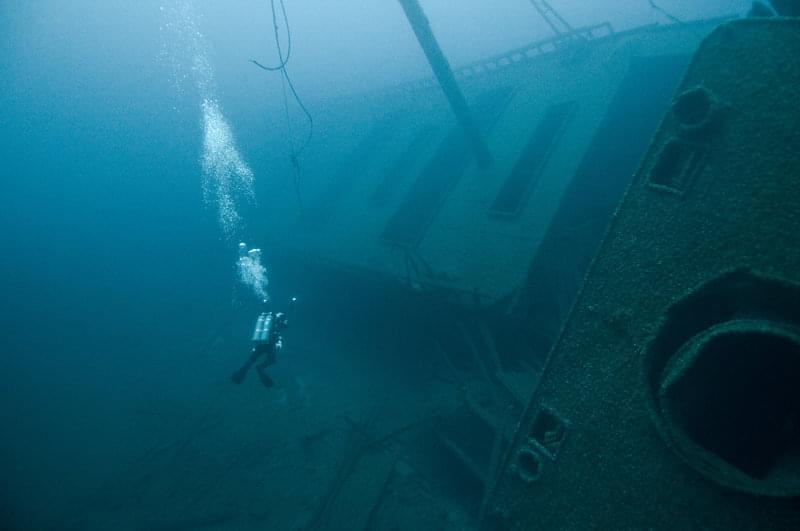
Protected from the high-energy of a shallow-water environment, deepwater shipwrecks are often very intact. Shipwrecks in this type of environment are true time capsules, providing unique and exciting archeological, historical, and recreational opportunities. Pictured here is the 300-foot long bulk freighter Norman, which sank in 1895. Resting in 64 meters (210 feet) of water just outside the current sanctuary boundaries, the wreck site is among the most exciting dives in the Great Lakes. Image courtesy of Thunder Bay 2010 Expedition, NOAA-OER. Download larger version (jpg, 256 KB).
Humans have used the waters of Thunder Bay and its shores for thousands of years. Geological and archaeological evidence suggests a high probability of prehistoric archaeological sites awaiting discovery. In addition to helping to protect and interpret individual sites, managing the sanctuary as a maritime cultural landscape reveals a broad historical canvas that can encompass many different perspectives to foster an interconnected understanding of the maritime past.
The maritime cultural landscape allows Thunder Bay’s maritime heritage to continue to unfold as new discoveries are made and encourages an increasingly diverse public to find shared meaning in this nationally and internationally significant place.
The Thunder Bay NMS is headquartered at the 20,000-square-foot Great Lakes Maritime Heritage Center. This state-of-the-art building features a 93-seat theater, 9,000 square-feet of exhibit space, distance learning capabilities, an artifact conservation lab, visible curatorial space, a technologically enhanced education room, a researchers’ field station, and administrative offices.
In 2008, the center became a Gold Certified Leadership in Energy and Environmental Design (LEED) building, a nationally accepted benchmark for the design, construction, and operation of high-performance green buildings. The center has also won two U.S. Department of Energy Awards — The You Have the Power Award and the Federal Energy Savers Award — and the General Services Administration Achievement for Real Property Innovation Award.
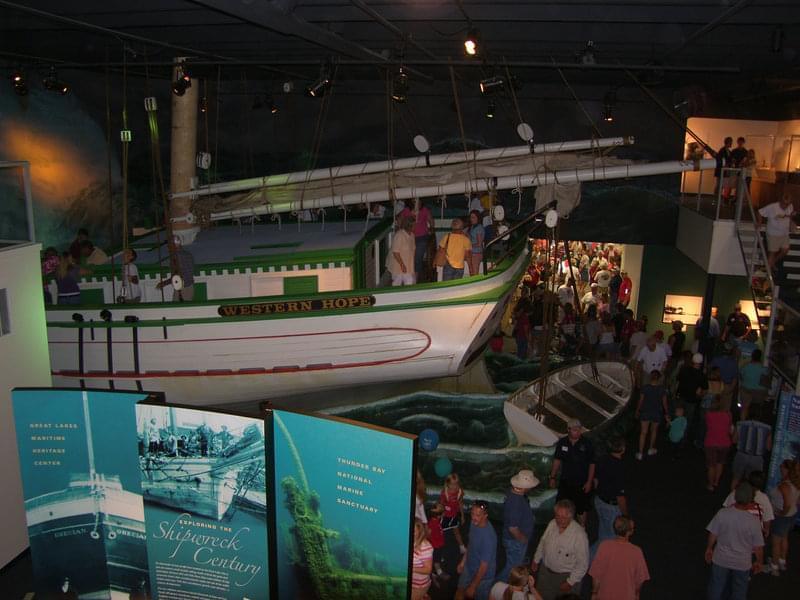
The Great Lakes Maritime Heritage Center is the headquarters for the Thunder Bay NMS. The state-of-the-art visitor center houses the exciting Shipwreck Century exhibit, which includes full-scale replicas of both a Great Lakes schooner and a shipwreck. Image courtesy of Thunder Bay 2010 Expedition, NOAA-OER. Download larger version (jpg, 678 KB).
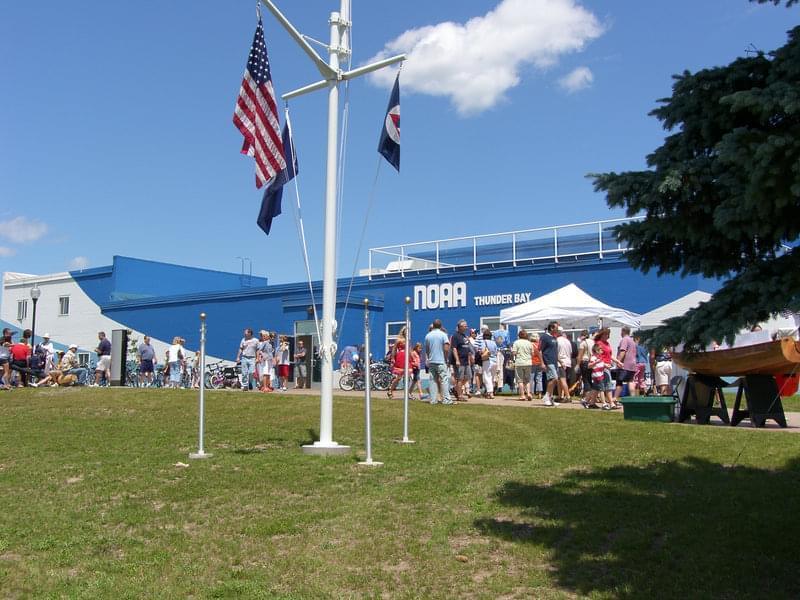
The Great Lakes Maritime Heritage Center is the headquarters for the Thunder Bay NMS. The state-of-the-art visitor center houses the exciting Shipwreck Century exhibit, which includes full-scale replicas of both a Great Lakes schooner and a shipwreck. Image courtesy of Thunder Bay 2010 Expedition, NOAA-OER. Download larger version (jpg, 919 KB).
The Office of National Marine Sanctuaries (ONMS) serves as the trustee for a system of 14 marine protected areas, encompassing more than 150,000 square miles of ocean and Great Lakes waters from Washington state to the Florida Keys, and from Lake Huron to American Samoa. NOAA’s National Ocean Service manages the national marine sanctuaries through the authority of the National Marine Sanctuaries Act of 1972
Marine sanctuaries contain deep-ocean gardens, coral reefs, whale migration corridors, deep-sea canyons, historically significant shipwrecks, and other underwater archaeological sites. They range in size from one-quarter square mile in Fagatele Bay, American Samoa, to more than 134,000 square miles at the Papahānaumokuākea Marine National Monument, located in the northwest Hawaiian Archipelago.
The ONMS fosters public awareness of marine resources and maritime heritage through scientific research, monitoring, exploration, education, and outreach, and works closely with its many partners and the public to protect and manage sanctuaries. The ONMS is a world leader in marine management by protecting living marine creatures, environmental quality, and maritime heritage resources, while maintaining recreational and commercial activities that are sustainable and compatible with long-term preservation.